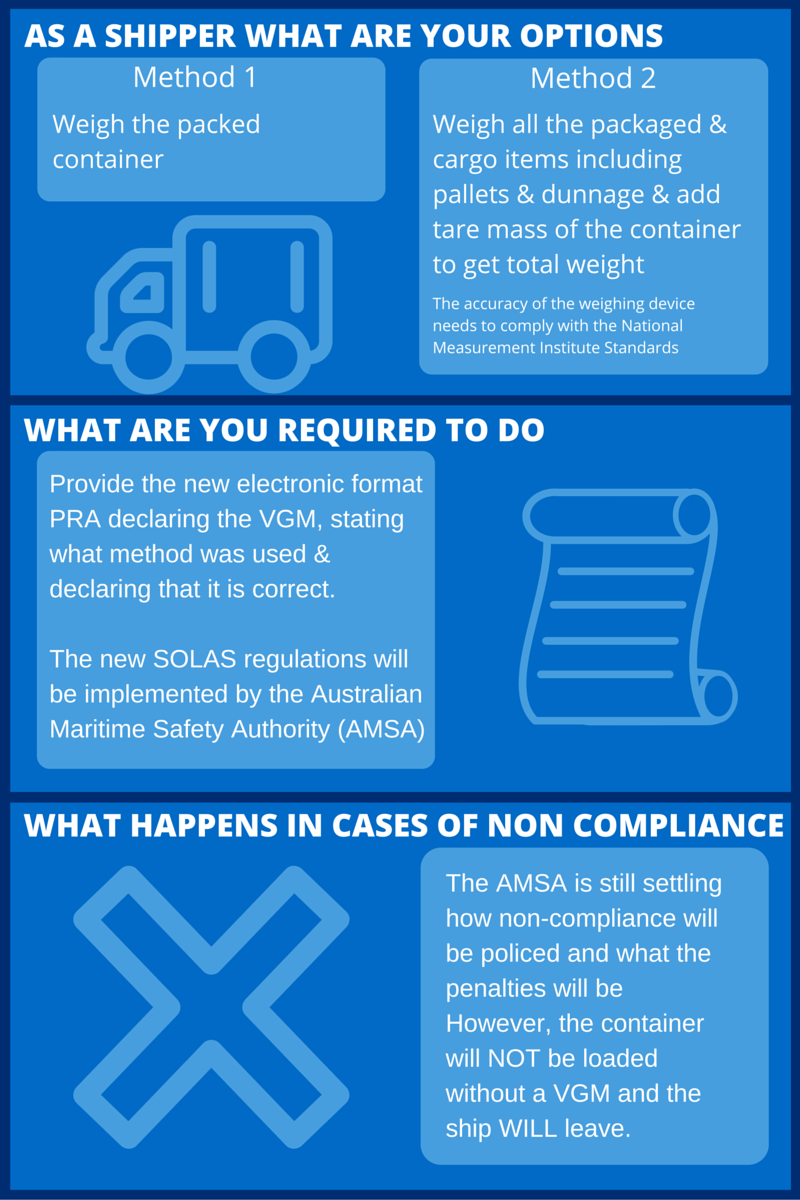Seabridge Global Logistics News
ARE YOU READY FOR JULY 1ST?
ON JULY 1 of this year, new Safety of Life at Sea (SOLAS) regulations will come into force. From this date forward it will be mandatory for each container loaded onto a ship engaged in an international voyage to declare Verified Gross Mass (VGM).
It is predicted that a large number of countries are not ready to implement the change in regulations. This will cause major headaches worldwide for shippers and other stakeholders in the container supply chain.
Seabridge has the expertise and the experience required to advise on the new SOLAS regulations. Please contact us with any queries about how this will affect you.
WHY IS THIS HAPPENING?
A number of accidents on vessels has caused attention to be drawn to the risk involved in overloading containers. While it is generally understood that overloading or misrepresenting weight may result in falling container stacks, containers overboard and accidents, recent incidents’ that have either caused or contributed to loss of life or loss of vessel, highlighting the need for review.
- The MSC Napoli in 2007 which grounded in the English Channel due to structural failure, where 20% of 660 checked containers were found to be more than three tonnes different from their declared weight.
- The sinking of the MOL Comfort in the Indian Ocean in 2013.
The IMO (International Maritime Organisation), which has 170 member states, started developing measures to prevent loss of containers in 2011.
Member states were consulted extensively during this process and on July 1, 2016 these guidelines will become law.
WHAT DOES THIS MEAN FOR YOU?
In order for a container to be loaded onto a ship, a VGM must be presented to:
– the ship’s master or his representative
– the terminal or its representative
The container shipper (or their loading partner) will be responsible for providing the VGM.

If a VGM is not provided the packed container will not be loaded on board the vessel.
There are two approved methods of calculating the VGM
Method 1: weighing the packed container
Method 2: weighing all the packages and cargo items (including pallets and dunnage), then adding the tare mass of the container to calculate the total weight.
These new regulations will be implemented by the Australian Maritime Safety Authority (AMSA) and they have published a revised draft of Marine Order 42 (Carriage, stowage and securing of cargoes and containers).
There is still deliberation underway over how this will be policed and if there will be penalties for non-compliance.
A new PRA (Pre-Receival Advice) electronic format has been developed. On this new PRA the shipper provides the VGM, the method used to verify the weight and signs this information off as being correct.
AMSA is still deciding on the acceptable limits of accuracy for the VGM calculation. However, the accuracy of the weighing device needs to comply with National Measurement Institute standards.
Terminal Operators
The onus is not on the terminal to weigh the container or to provide facilities with which the container can be weighed.
- Patrick, DP World and Hutchinson Ports Australia, have indicated that they will not be offering facilities for weighing containers at their terminals.
- Flinders Adelaide Container Terminal has not yet confirmed its position.
- Victoria International Container Terminal, scheduled to commence operations later this year at Webb Dock, Melbourne, has communicated it might be willing to provide a weighing service.
The Australian Maritime Safety Authority (AMSA) has published a revised draft of Marine Order 42 (Carriage, stowage and securing of cargoes and containers) and has requested comments from the industry.
INTERNATIONALLY
The fact that many countries are not ready to implement the new regulations has led to fears that global supply chains will grind to a halt.
A number of international terminal operators, including APM Terminals have said they will be providing a weighing service at a number of their facilities.
However, this will not be feasible option for many international terminal operators.
In Rotterdam, a large Dutch freight forwarder test-weighed a number of export containers and found discrepancies of up to 14%.
The Port of Rotterdam processes 10,000 export containers per week and has only five weighbridges.
A quick calculation by Lloyds List has shown that if every container was to be weighed, the weighbridges would have to be in operation around the clock, handling 12 containers an hour.
Obviously, for containers to be weighed at the terminal the efficiency of these facilities will be greatly affected.
IT IS HAPPENING SO BE PREPARED.
There has been push back from some of the shipper’s associations, including the Agricultural Transportation Coalition in the USA, who said that it had not been consulted.
However, IMO Secretary-General Kitack Lim issued a warning to all member states stating that they were all consulted and not one objection was received during the prescribed period for submissions.
In Australia information seminars will be held in most capital cities in the future to provide further clarity for shippers and stakeholders in the container supply chain.
A number of organisations, such as AMSA, Container Transport Alliance Australia (CTAA), the Australian Peak Shippers Association (APSA), the Freight & Trade Alliance (FTA), 1-Stop Connections and ICHCA Australia will present information at these sessions to ensure a smooth transition to the new regulations.
At Seabridge we specialise in International Freight Forwarding and have extensive experience in navigating and adhering to changing regulations. We can find the best solutions for VGM, working together with you and third parties in the transportation chain. If you have any further concerns about the upcoming changes, please do not hesitate to contact us.
 Australia
Australia New Zealand
New Zealand 